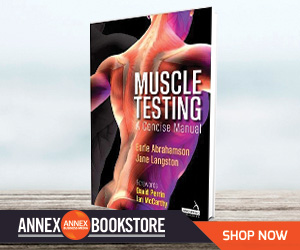| |
| |
| |
 |
|
@{mv_date_MMM d, yyyy}@ |
|
| |
 » Read more...
» Read more...
» Read more...
» Read more...
|
| |
|
| |

Muscle testing – A Concise Manual, provides a reference for understanding how structure relates to function, and how by knowing function we can learn structural configurations. Often muscular anatomy is taught as a dry subject whereby each muscle is painstakingly reviewed and the learner is expected to cite origin, insertion, action, nerve supply and blood supply. This commonly used approach may not necessarily aid understanding of muscle function, nor does it demonstrate muscular positioning. Through muscle testing, one is better equipped to consider how muscles function individually and in working groups. It is the knowledge of symmetrical movement, range of motion, contractile patterns, resistance and gravity that provides the fuller picture for muscle function and dysfunction.
>> Order now |
| |
|
| |
 The effect of exercise on health is profound. It can protect you from a range of conditions, including heart disease, type 2 diabetes and some cancers. But the type and amount of exercise you should do changes as you age. To ensure that you or your patients are doing the right type of exercise for their age, follow this simple guide. (Includes childhood and adolescence, 20s, 30s, 40s, 50s, 60s, 70s and beyond.)
» Learn more
The effect of exercise on health is profound. It can protect you from a range of conditions, including heart disease, type 2 diabetes and some cancers. But the type and amount of exercise you should do changes as you age. To ensure that you or your patients are doing the right type of exercise for their age, follow this simple guide. (Includes childhood and adolescence, 20s, 30s, 40s, 50s, 60s, 70s and beyond.)
» Learn more |
| |
|
| |
|
|
| |
| |



